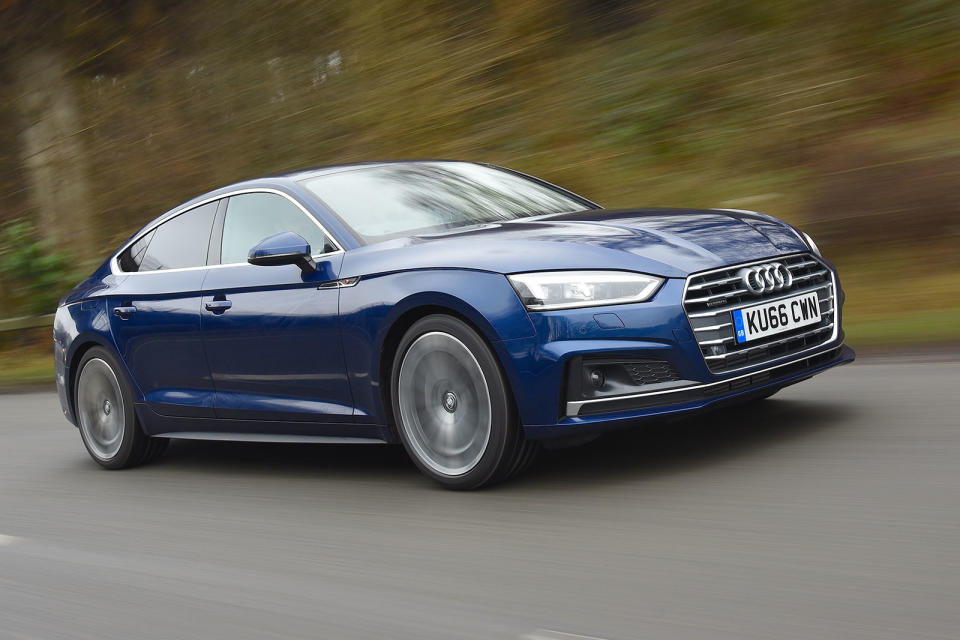Audi A5

In a universe of infinite possibilities, there must be a reality in which Audi ’s 2009 marketing wheeze of retrofitting the Audi A5 coupé with rear doors and a hatchback boot (and charging significantly more for it than the mechanically identical Audi A4) was met with buyer contempt.
Here, though, and despite the aftershock of recession, the frameless doors and more shapely body were a moderate hit, and the car was easily successful enough for Audi to deliver much the same overhaul that has already been visited on the A4 and the A5 coupé.
The look has changed, but not substantially. The Sportback’s core theme is its retention of an eye-pleasing profile, meaning there’s nowhere for that distinctive rear roofline to go but quickly down to meet up with the jaunty back end.
At the front, the Sportback receives much the same single-frame grille revision and wraparound bonnet front as previewed on the coupé and has been exhibited on the cabriolet as well.
Equally important (perhaps more so if you’re underwhelmed by the exterior) is the cabin revamp, which upgrades the fixtures and fittings and swells the interior gently in size.
The latter is thanks to the Sportback adopting the same MLB Evo architecture used for the A4. The engines are carried over, too, although not all of them; to maintain its more exclusive status, the A5 can’t be bought with Audi’s smaller petrol units or even its omnipresent 148bhp 2.0 TDI.
Instead, the three TDI and one TFSI options are made up of headier choices, even if the trim levels – SE, Sport and S Line – remain.
The focus on a higher tempo urged us to look at the 249bhp 2.0 TFSI, Audi’s idea of a spiritual successor to the bigger six-cylinder petrol engine now only offered with the Audi S5.
The 2.0-litre four-pot comes with quattro as standard (most Sportbacks will be front-wheel drive) and a seven-speed S tronic dual-clutch automatic gearbox, so it ought to be the version best suited to convincing us that Audi’s five-door coupé can deliver performance to complement its style.
Audi A5 design & styling
The MLB-underpinned Sportback enjoys the same advantages already showcased by the current A4, in that it is marginally longer and wider than the car it replaces and significantly lighter.
Without the full range of downsized engines, the A5 can’t quite claim to have shed the same 120kg its saloon sibling managed, but the “as much as” 85kg quoted by Audi helps the model tested to achieve a respectable 1535kg kerb weight.
The weight loss can be attributed not only to the platform’s mix of aluminium and high-strength steel, but also the kind of far-reaching effort that results in the through-load seat frame being made of magnesium and the carpets being ‘weight-optimised’.
Such attention to detail is admirable and of benefit to both efficiency and performance.
The performance-orientated 249bhp 2.0 TFSI doesn’t share the clever Miller cycle timing of the 188bhp version that is currently available in the A5 coupé and A4 estate and saloon here in the UK, but it is nevertheless armed with Audi’s valve lift system and all the other bells and whistles required to deliver 273lb ft from 1600rpm while emitting just 144g/km of CO2.
The 188bhp 2.0 TDI unit trumps that with 295lb ft (equalling the 215bhp 3.0 TDI’s peak twist), and is offered with a six-speed manual gearbox and front-wheel drive, if you go for entry-level spec.
Most people, though, will opt for the seven-speed S tronic transmission, newly fettled for the job and attachable to any engine save the forthcoming 282bhp 3.0 TDI and the 349bhp 3.0 V6 TFSI in the S5, both of which will use the latest iteration of Audi’s eight-speed Tiptronic torque converter automatic.
Whichever drivetrain you opt for, the Sportback’s suspension is by way of a revised five-link axle at the front and an entirely new one at the rear, where its predecessor had a heavier trapezoidal-link.
Our test car had standard passive sport suspension; adaptive dampers are a £600 option.
Audi’s Drive Select, though, is featured across the range, as is a revised electromechanical steering rack. The 2.0 TFSI tested gets the quattro-branded self-locking centre differential that defaults to a 40 percent front, 60 percent rear torque split, although 70 percent to the front or 85 percent to the rear is possible. An additional sport diff for the back axle is limited to the option list of the S5 and top-spec TDI.
]]>

 Yahoo Autos
Yahoo Autos 